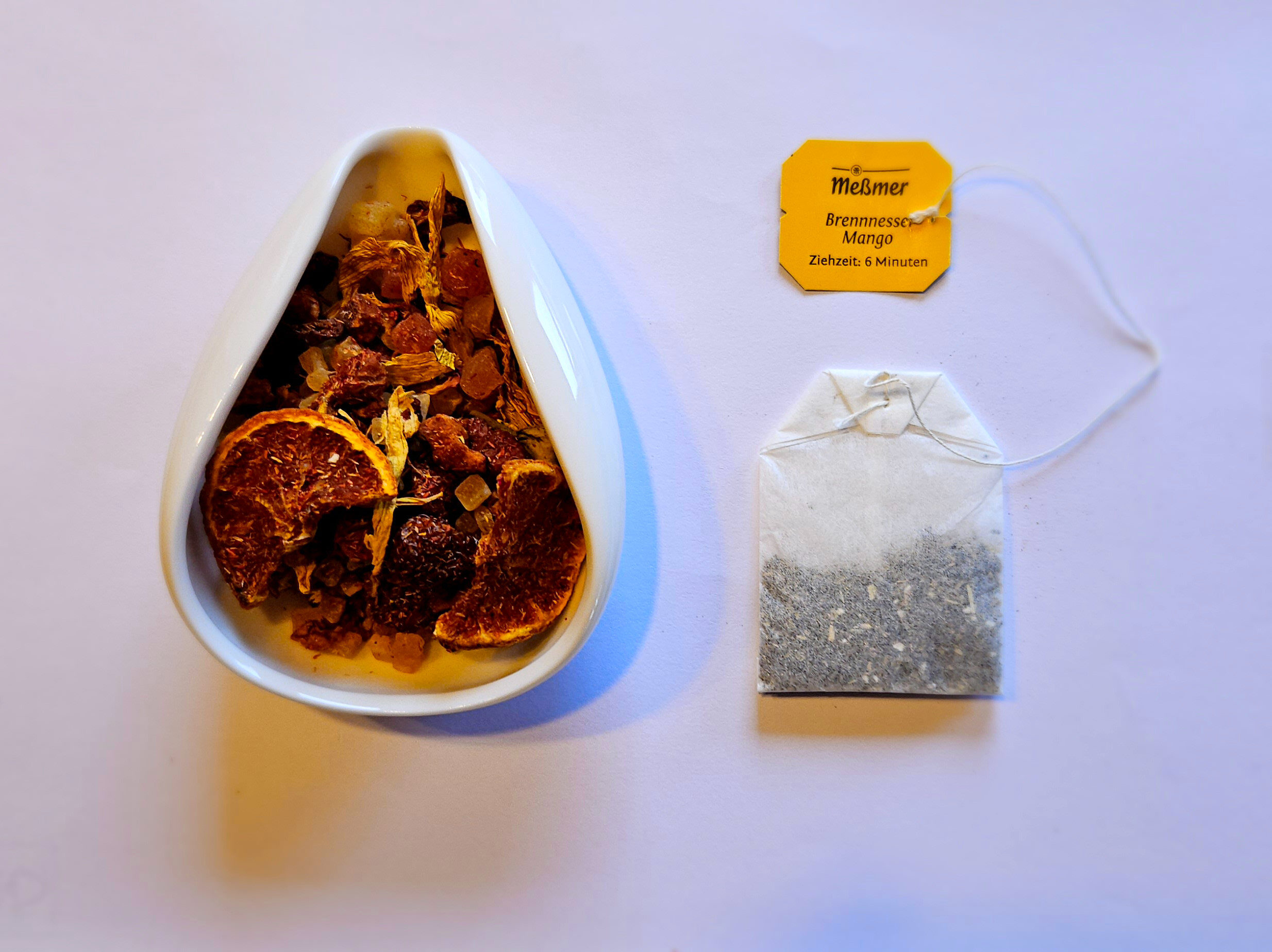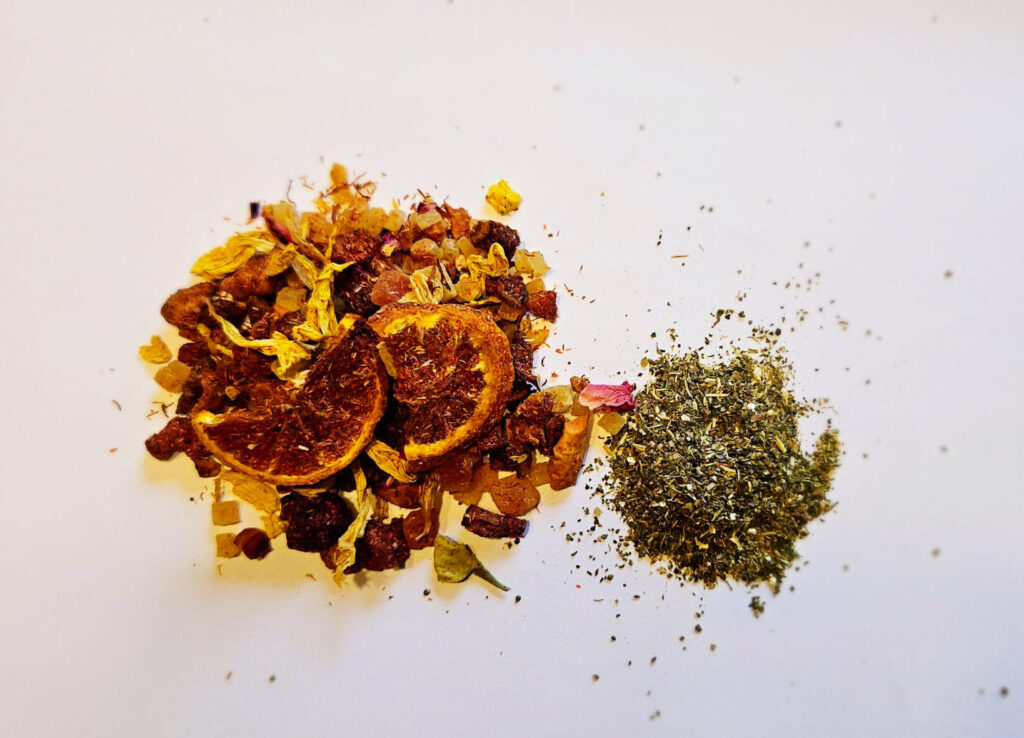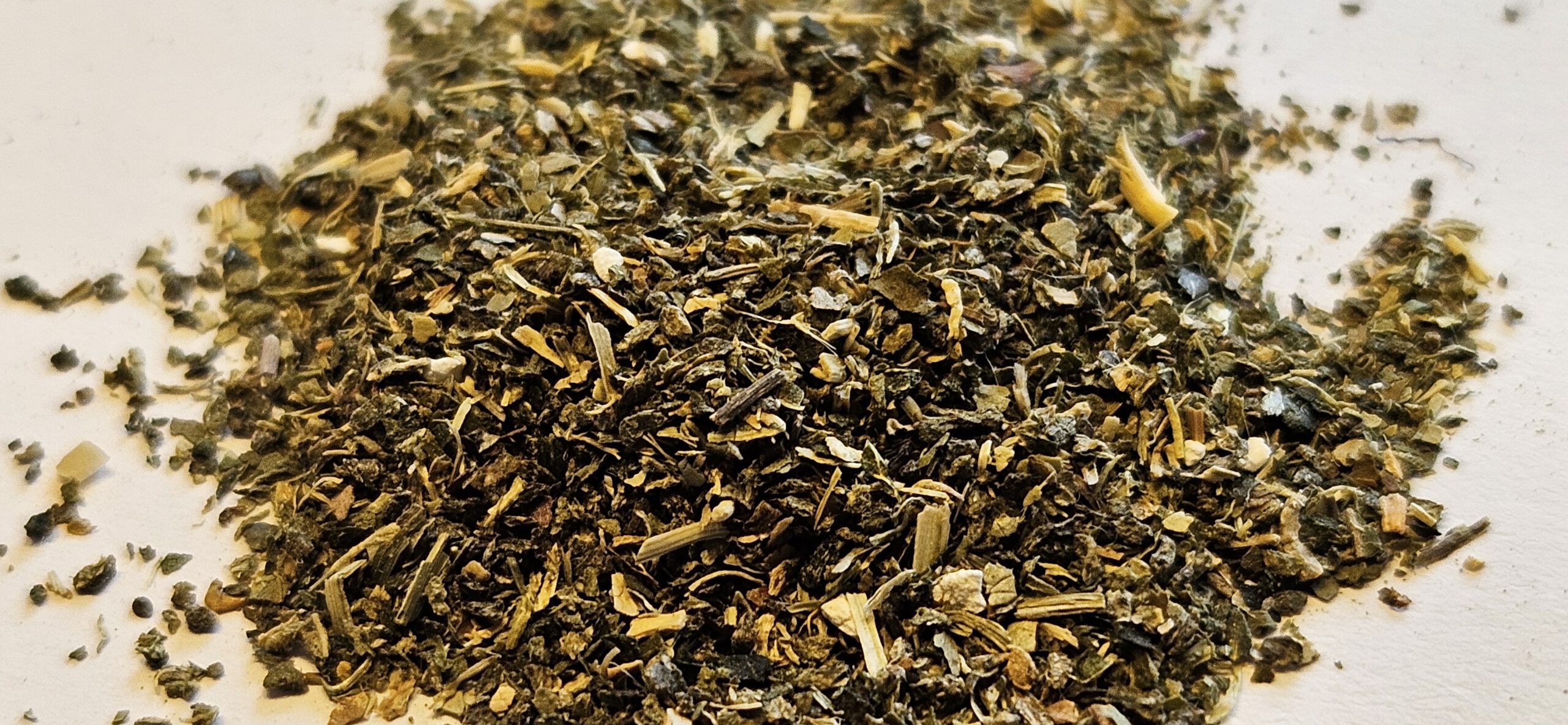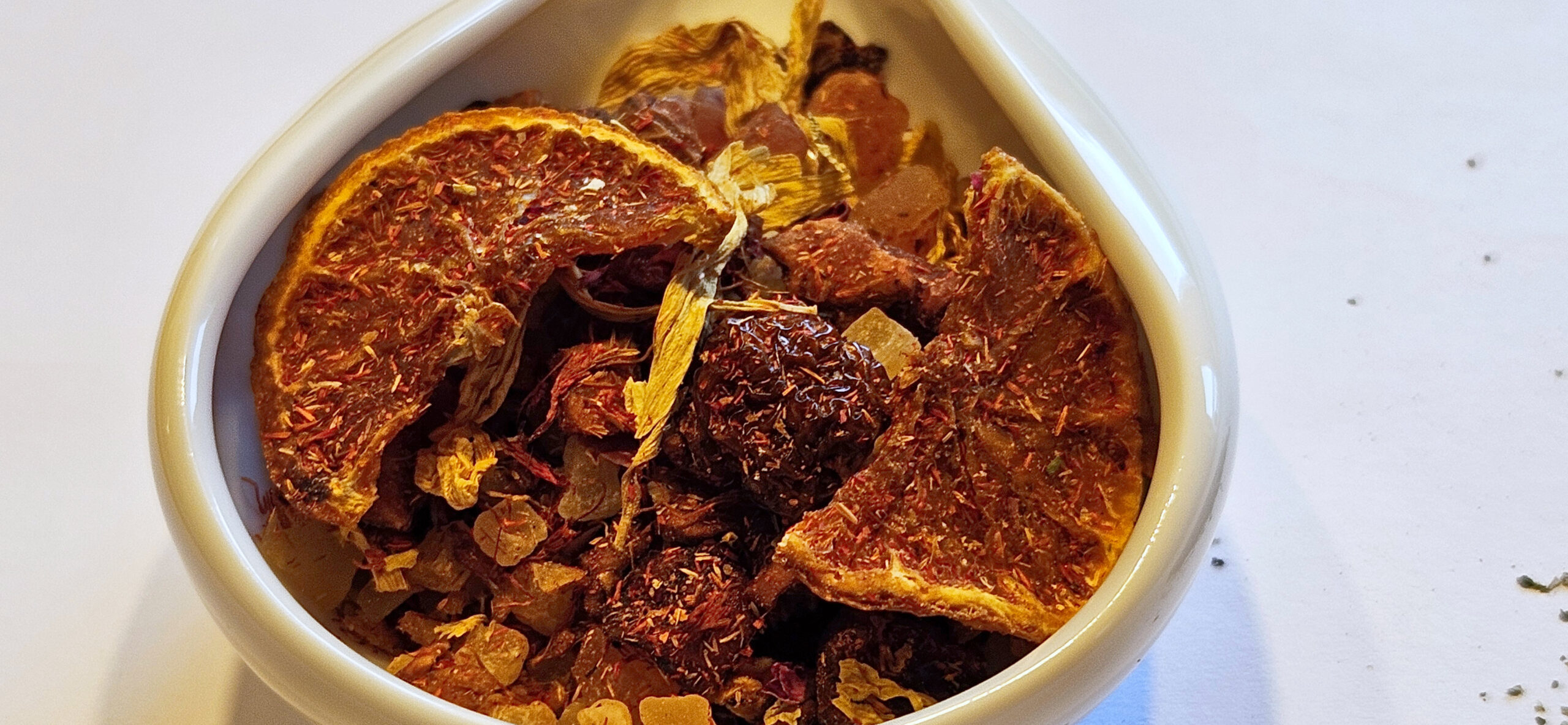Tee zählt weltweit zu den beliebtesten Getränken, geschätzt für seine Vielfalt, sein Aroma und seine gesundheitlichen Vorteile. Egal ob Früchtetees, Kräuter Tees, oder ein klassischer Grüntee, die Auswahl ist riesig. Eine der grundlegendsten Entscheidungen, die Teeliebhaber treffen, betrifft die Form des Tees: Soll man Tee im Beutel oder lose wählen? Oder anders gefragt: Ist loser Tee besser als Beutel? Diese Fragen mögen auf den ersten Blick einfach erscheinen, doch sie öffnen die Tür zu einer Abwägung über Geschmack, Bequemlichkeit, Qualität und Umweltauswirkungen. In diesem Artikel wollen wir die Unterschiede zwischen Tee im Beutel und losem Tee erkunden, die Vor- und Nachteile beider Methoden abwägen und herausfinden, wie sich diese Wahl auf die Qualität auswirkt.

Wie unterscheidet sich der Tee im Beutel von losem Tee?
90 Prozent der Deutschen kaufen ihre Kräuter- und Früchtetees in Beuteln. Beuteltee muss also ein paar Vorteile bieten, oder? Naja, das schauen wir uns gleich an. Teekenner schwören jedenfalls auf losen Tee und das hat gute Gründe. Bei Schwarz- und Grüntees werden interessanterweise viel eher lose Tees gekauft. Hier liegt das Verhältnis loser Tee vs Teebeutel bei 45 zu 55 Prozent. Spezialitäten wie weißen Tee, Oolong oder Pu Erh gibt es dagegen nur äußerst selten in Teebeuteln zu kaufen.
Tee-Staub oder ganze Blätter?
Vergleicht man den Inhalt von Teebeuteln mit losem Tee, werden die Qualitätsunterschiede schnell ersichtlich. Hochwertiger loser Tee besteht aus ganzen Blättern, Pflanzenteilen oder Gewürzen. In Teebeuteln hingegen werden oft die Überreste verarbeitet, der sogenannte Tee-Staub. Wie der Name andeutet, handelt es sich dabei um sehr kleine Partikel. Auch beliebt in der Tee-Industrie: CTC-Tee, eine Abkürzung für “Crush, Tear, Curl” (Zerquetschen, Zerreißen, Rollen). Sie kommt vor allem bei Schwarztee zum Einsatz. Bei diesem Verfahren werden die frisch gepflückten Teeblätter zunächst mechanisch zerkleinert, dann zerrissen und schließlich zu kleinen, harten Pellets gerollt. Dieser Prozess intensiviert die Oxidation der Blätter, was zu einem Tee führt, der eine stärkere Farbe, einen kräftigeren Geschmack und eine höhere Haltbarkeit aufweist als lose Blatttees. Während der intensive Bearbeitungsprozess zu einem starken Geschmack und einer schnellen Zubereitung in der Tasse führt, kann er auch die feineren Aromen und Nuancen zerstören, die in hochwertigem, losem Tee zu finden sind.
Granulat vs. getrocknete Früchte

Bei Früchtetees wird der Unterschied von Tee im Beutel oder lose sogar noch besser sichtbar. Um das zu veranschaulichen habe ich mal einen Teebeutel aufgeschnitten und seinen Inhalt direkt mit losem Tee verglichen. Wie du siehst, findest du in hochwertigem Tee ganze Früchte oder große Stücke davon. Die hätten in einem Teebeutel schlicht keinen Platz. Um den Geschmacksvorteil der losen getrockneten Früchte auszugleichen, hat die Industrie Frucht-Granulate entwickelt. Diese enthalten allenfalls Fruchtkonzentrate, meistens mit künstlichen oder natürlichen Aromen verstärkt.
Vorteile von Beuteltee

Standardisierter Geschmack
Beuteltee wird in der Regel aus vielen verschiedenen Tees zusammengemischt. Ziel ist es einen gleichbleibenden Geschmack zu gewährleisten. So kannst du dir sicher sein, dass dein Tee immer gleich schmeckt, egal ob du ihn heute kaufst oder in einem Jahr. Ob man das nun als Vor- oder Nachteil wertet, bleibt deinem individuellen Geschmack überlassen. Manch einer bevorzugt Abwechslung und schätzt die natürlichen Veränderungen in jeder Tee-Ernte. Andere bleiben lieber bei Altbewährtem.
Dosierbarkeit und Einfachheit
Teebeutel haben die Art und Weise, wie viele Menschen ihren Tee genießen, revolutioniert, indem sie eine unvergleichliche Dosierbarkeit und Einfachheit bieten. Die kleinen, vorportionierten Beutel enthalten genau die richtige Menge an Teeblättern für eine Tasse. Diese Bequemlichkeit ist besonders vorteilhaft für Teetrinker, die einen schnellen und unkomplizierten Weg suchen, ihr heißes Getränk zu genießen, ohne sich mit Messlöffeln oder Waage beschäftigen zu müssen. Nach der Zubereitung können sie einfach und sauber entsorgt werden. Die Einfachheit der Teebeutel macht sie zu einer guten Wahl für das Büro, Reisen oder andere Situationen, in denen Bequemlichkeit und Schnelligkeit im Vordergrund stehen.
Nachteile der Teebeutel
Kein Raum zur Entfaltung
Wie so oft im Leben brauchen gute Dinge Platz zur Entfaltung. Dieser Platz ist in Beuteln schlicht nicht gegeben. Große Fruchtstücke und Blätter passen schon in der getrockneten Form kaum in einen Teebeutel. Wenn sie sich mit Wasser vollsaugen, vergrößern sie ihr Volumen oft erheblich. Aus diesem Grund solltest du für losen Tee übrigens auch kein Tee-Ei verwenden. Wenn du gerade keinen Tee-Sieb zur Hand hast, findest du in diesem Artikel Möglichkeiten deinen losen Tee ohne Sieb zuzubereiten.
Um den Inhalt trotzdem in die Beutel zu bekommen, verwenden die Hersteller den erwähnten Tee-Staub oder das Fruchtgranulat, welche sich nicht so stark ausdehnen.
Mindere Qualität und bitterer Tee
Tee-Staub, der oft in Teebeuteln zu finden ist, neigt dazu, einen bitteren und weniger nuancierten Geschmack zu entwickeln, da die feinen Partikel eine Überextraktion begünstigen. Dieser Effekt wird noch verstärkt, wenn man bedenkt, dass bei der Zubereitung von Früchtetees, deren Aromen und Säuren sich unterschiedlich im Wasser lösen, die Kontrolle über den Extraktionsprozess entscheidend für ein ausgewogenes Geschmackserlebnis ist.
Darüber hinaus führt die schnelle Freisetzung der Inhaltsstoffe aus den kleinen Tee-Partikeln dazu, dass die subtilen Aromen und die Tiefe, die man von hochwertigeren Blatttees oder ganzen Fruchtstücken erwarten würde, verloren gehen, was zu einem eindimensionalen und oft enttäuschenden Heißgetränk führt. Infolgedessen können Teetrinker, die Wert auf Geschmacksvielfalt und -qualität legen, mit Teebeuteln nicht die volle Bandbreite und Komplexität der Aromen erkunden, die Tee und Früchtetees bieten können.
Verliert schneller Aroma
Nicht nur bei der Zubereitung, auch bei der Lagerung verliert der Tee in Beuteln schneller an Aroma. Durch die feinen Partikel haben die Tees eine viel größere Oberfläche, über die sie Aromen verlieren können. Außerdem nehmen die Teebeutel dadurch schneller Luftfeuchtigkeit und Fremdgerüche auf.
Mehr Abfall
Die Bequemlichkeit von Teebeuteln hat eine weitere Kehrseite: Mehr Müll. Jeder Teebeutel, oft einzeln in Plastik oder Papier verpackt, erzeugt Abfall. Darüber hinaus bestehen viele Teebeutel nicht nur aus Papier, sondern enthalten auch Kunststofffasern, die ihre Stabilität beim Aufbrühen erhöhen sollen. Diese Zusammensetzung erschwert das Recycling und führt dazu, dass Teebeutel Jahre, wenn nicht gar Jahrzehnte, benötigen, um sich vollständig abzubauen. Wer trotzdem Tee in Beuteln bevorzugt, sollte darauf achten, dass der Beutel aus ungebleichter Zellulose oder Seidenpapier besteht. Wenn du die Beutel über den Bio-Müll entsorgst, solltest du vorher das Etikett abmachen, damit keine Druckerfarbe oder Metallklammern in den Kompost gelangen.
Öfters von Pestiziden belastet?
Die Sorge um Pestizidrückstände in Teebeuteln ist nicht unbegründet, insbesondere wenn es um Schwarztees geht, die oft aus industriellen Massenproduktionen stammen. Länder wie Kenia, ein führender Exporteur von Billig-Schwarztee, stehen im Mittelpunkt dieser Bedenken aufgrund ihrer niedrigen Umwelt- und Arbeitsschutzstandards. In solchen Regionen kann der Einsatz von Pestiziden in der Teeproduktion höher sein, um den Ertrag zu maximieren und die Pflanzen vor Schädlingen zu schützen.
Dies wird zusätzlich dadurch kompliziert, dass der Tee für Teebeutel oft aus Mischungen verschiedener Ernten besteht, was die Rückverfolgbarkeit und Kontrolle der Pestizidbelastung erschwert. Obwohl viele Teeproduzenten und Marken strenge Qualitätskontrollen durchführen und sich zunehmend um nachhaltige und pestizidfreie Anbaumethoden bemühen, bleibt die Sorge um Pestizidrückstände in Teebeuteln, besonders bei Produkten aus industrieller Massenproduktion, eine relevante Überlegung für gesundheitsbewusste Verbraucher. Loser Tee wird dagegen, in der Regel, in kleineren Mengen produziert, was den Druck der Bauern zu Massenproduktion verringert. Beim Test von 24 schwarzen Tees durch Ökotest schnitten vor allem Beuteltees auffallend schlecht ab (auch manche losen Tees konnten die Prüfer leider nicht überzeugen). Daher werden all unsere Tees Laborkontrollen unterzogen, um sicherzustellen, dass sie den hohen deutschen Anforderungen entsprechen.
Vorteile Loser Tee

Aus vielen der genannten Nachteile von Beuteltees werden schon die Vorteile von losem Tee ersichtlich. Hier noch ein paar weitere Gründe, warum Loser Tee besser als Beutel ist…
Vielfalt
Wenn du im Supermarkt vorm Regal mit den vielen bunten Beuteltees stehst, kann der Eindruck entstehen es gäbe eine große Auswahl. Wenn du aber mal in ein Tee-Fachgeschäft gehst, oder in einem Tee – Onlineshop stöberst wirst du feststellen, dass die Vielfalt loser Tees seeehr viel größer ist. Neben einer Vielzahl von Kräuter- und Früchtemischungen findest du vor allem auch klassische Tees wie gelben Tee oder Pu Erh, die du niemals in Beuteln finden kannst.
Wie bereits erwähnt, wird bei Tee-Beuteln stets darauf geachtet einen standardisierten, gleichbleibenden Geschmack anbieten zu können. Außergewöhnliche Geschmacksnuancen und Abwechslung wirst du in einem Teebeutel nicht finden.
Geschmackstiefe
Dem hochwertigeren Blatt Tee kannst du eine Vielzahl an geschmacklichen Nuancen entlocken. In Oolong Tee kannst du z.B. eine cremige Süße, zarte Blumigkeit, Nuancen von Früchten, Holz, Nüssen, Schokolade und vielem Mehr finden. Wenn du noch nie hochwertigen losen Tee probiert hast, wird sich dir eine komplett neue Welt an Aromen erschließen. Hier mal eine Übersicht, welche Vielfalt alleine Oolong-Tees bieten können. Im direkten Vergleich loser Tee vs Teebeutel wirst du beeindruckende Unterschiede feststellen können. Danach willst du wahrscheinlich nie wieder die eindimensionalen Supermarkt-Beutel kaufen.
Individueller in der Zubereitung
Du magst deinen Tee lieber kräftiger, milder, saurer, süßer, herber? Mit losem Tee hast du’s in der Hand, indem du die Dosierung und Ziehzeit anpasst. Du kannst z.B. ein viel stärkeres Tee-Wasser-Verhältnis wählen und dafür die Ziehzeit auf wenige Sekunden reduzieren, um dem Teeblatt in mehreren Aufgüssen nach und nach verschiedene Nuancen zu entlocken.
Rituelle Zubereitung
Zu guter Letzt kann die Zubereitung von losem Tee auch etwas Rituelles haben. Den losen Tees zu dosieren und in ein Sieb zu geben, mit heißem Wasser zu übergießen und zu beobachten, wie sich der Tee langsam entfaltet, wird zu einer beruhigenden Routine. Ebenso wie das achtsame Genießen und Entdecken der einzelnen Geschmacks-Nuancen.
Preisunterschiede loser Tee vs Teebeutel
Preislich unterscheiden sich loser Tee und Tee in Beuteln oft signifikant. Auf den ersten Blick erscheinen Teebeutel günstiger. Aber welcher Tee bietet tatsächlich das bessere Preis-Leistungs-Verhältnis? Loser Tee oder Teebeutel? Vielleicht überrascht es dich, aber in der Regel ist es der lose Tee. Dies liegt nicht nur an der höheren Qualität und den intensiveren Aromen, die man bei losem Tee für sein Geld erhält, sondern auch an der Möglichkeit, denselben Tee mehrfach aufzugießen. Viele Teesorten, besonders klassische Tees und viele Kräuter, entfalten ihre Geschmacksnuancen über mehrere Aufgüsse hinweg, wobei jeder Aufguss ein einzigartiges Geschmackserlebnis bietet. Teebeutel hingegen sind in der Regel für einen einmaligen Gebrauch konzipiert und bieten selten die Qualität oder die Möglichkeit, mehrfach aufgegossen zu werden, ohne an Geschmack zu verlieren.
Obwohl der Anschaffungspreis von losem Tee zunächst höher erscheinen mag, ermöglicht die Mehrfachverwendung eine effiziente und kostengünstige Option für Teeliebhaber. In Anbetracht der Menge an Aufgüssen, die man aus einer bestimmten Menge losen Tees gewinnen kann, relativiert sich der Preisunterschied, sodass loser Tee oft die wirtschaftlichere Wahl ist.
Fazit: Tee im Beutel oder lose?
Nach Abwägung der Vor- und Nachteile, vor allem aber des deutlich besseren Geschmacks, der höheren Qualität und der größeren Vielfalt, gibt es im Vergleich loser Tee vs Teebeutel für mich persönlich einen klaren Gewinner: Losen Tee! Wenn du es im Alltag lieber schnell und unkompliziert magst, sind Teebeutel vielleicht die richtige Wahl für dich. Hochwertigen losen Tee kannst du z.B. in unserem Onlineshop kaufen.
Häufige Fragen
Ist Tee in Beuteln auch gesund?
Ja, Tee in Beuteln kann ebenfalls gesund sein, da er dieselben grundlegenden Inhaltsstoffe wie loser Tee enthält, einschließlich Antioxidantien und anderen nützlichen Verbindungen. Allerdings sind Beuteltees in der Regel von niedrigerer Qualität als lose Tees und sind überdurchschnittlich oft mit Pestiziden belastet.
Warum loser Tee?
Loser Tee wird oft wegen seiner höheren Qualität und Vielfalt bevorzugt. Die Verwendung ganzer Blätter ermöglicht eine vollere Entfaltung des Geschmacks und der Aromen im Vergleich zu den feineren Blättern oder dem “Dust” in Teebeuteln. Zudem erlaubt loser Tee eine bessere Kontrolle über die Stärke des Tees und bietet ein authentischeres Teeerlebnis.
Warum ist loser Tee teurer?
Loser Tee ist aufgrund der Verwendung höherwertiger Blätter oft teurer als Tee in Beuteln. Die höheren Kosten spiegeln die überlegene Qualität und das reichere Aroma. Ein wichtiger Aspekt, der die Mehrkosten relativiert, ist jedoch, dass viele Sorten losen Tees mehrfach aufgegossen werden können, ohne signifikant an Geschmack zu verlieren. Dies bedeutet, dass trotz des höheren Anschaffungspreises der Preis pro Tasse durch mehrere Aufgüsse oft ähnlich oder sogar günstiger als bei Teebeuteln sein kann.

